- Author: Kathy Keatley Garvey

Native Brazilian Walter Leal, chemical ecologist and professor in the UC Davis Department of Molecular and Cellular Biology, is there.
So is the mosquito.
At the symposium today, Constancia Ayres, research coordinator of the Oswaldo Cruz Foundation (Centro de Pesquisa Aggeu Magalhaes/FIOCRUZ, considered one of the oldest and most prestigious scientific research institutes in South America), reported that the common southern house mosquito, Culex quinquefasciatus, may be a potential vector of the Zika virus.
Studies in the Ayres lab confirmed that Culex quinquefasciatus infected with Zika (isolated from local patients) showed high transmission rate (as determined by virus replication in the salivary glands).

Of course, these studies were done in the lab, not the field, and this is the beginning of the research.
We asked medical entomologist William Reisen, editor of the Journal of Medical Entomology, and professor emeritus, Department of Pathology, Microbiology and Immunology, UC Davis School of Veterinary Medicine, about this.
"In California less than 3 percent of the Culex including Cx. quinquefasciatus have been found to feed on humans, even in cities like Los Angeles, where humans are the most numerous host," Reisen said in an email. "Therefore, even if they are susceptible to infection, the probability of a female feeding on humans to acquire and then refeed on humans to transmit would be 0.03 x 0.03 = 0.0009 or a rare event indeed. That said, there are areas of the world where quinquefasciatus feeds predominantly on humans in domestic settings. (See his research paper, Host Selection Patterns of Some Pakistan Mosquitoes (U.S. National Library of Medicine, National Institutes of Health).
In his research paper on Pakistan mosquitoes, Reisen mentions Culex pipiens fatigans, now known as Culex quinquefasciatus. Its feeding patterns "varied opportunistically with host availability," he wrote in the abstract. Resting in cattle sheds during the winter, it "fed on birds and bovids, changing to man and bovids during the spring and then to man and birds during summer."
Medical entomologist Thomas Scott, distinguished professor of entomology (now emeritus) of the UC Davis Department of Entomology and Nematology, is a global authority on Aedes aegypti, which transmits dengue, yellow fever, chikungunya and the Zika viruses.
"Vector competence studies in the lab is valuable information, but before we come to the conclusion that Culex quinquefasciatus is an important contributor to transmission of Zika virus, the lab results would need to be confirmed," Scott told us. "Other laboratories and appropriate field studies would need to be carried out in areas where Zika virus is being transmitted to confirm that this species is naturally infected and is regularly biting people. Although it is a potentially important discovery that would change they way we think about Zika virus transmission, it would be wise to carefully explore all of the details necessary to incriminate a mosquito vector before coming to a strong conclusion."
UC Davis medical entomologist Anthony Cornel of the Kearney Agricultural Research and Extension Center and UC Davis Department of Entomology and Nematology, weighed in: "I have to examine the vector competence data carefully to determine its infectivity dose relative to Aedes aegypti. If Culex quinquefasciatus does play an additional role in transmission then it would be of even greater concern because the threat of autochthonous transmission will occur in areas other than where Aedes aegypti is found in California. Culex quinquefasciatus also feed on people but do so at dusk and at night."
"Brazil could be facing a greater fight against the zika virus than previously feared as researchers investigate whether the common mosquito is transmitting the disease," Moraes wrote in the article, headlined "Brazilian Experts Investigate if 'Common Mosquito' is Transmitting Zika Virus."
"The Aedes aegypti species of mosquito was thought to be solely responsible for spreading the virus," Moraes pointed out. "But scientists are now studying whether the Culex mosquito--the variety (species) most commonly found in Brazil--could also be passing on the infection."
Constancia Ayres was quoted as saying: "This may be the reason for the virus replicating faster. The interaction of the mosquito with the virus may explain the epidemiological profile of disease transmission.”
Meanwhile, the headlines continue as research proceeds.
The Outbreak News Today related that researchers in the Ayres lab "are now investigating the possibility that other, non-Aedes mosquito species, might carry and spread Zika and Chikungunya."
"The concern is that the Culex mosquito--which is 20 times more prevalent than the Aedes variety in Brazil-- might also play some role in the rapid spread of these viruses," Outbreak News Today noted. "Researchers hope to have some answers in a few weeks,"
Valor.com.br is hot on the story as well. Reporter Marina Hawk emphasized that the work was done in the lab, but field collection is underway.

- Author: Kathy Keatley Garvey
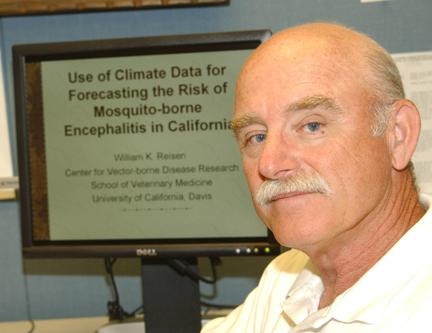
He's a medical entomologist through and through.
So when UC Davis medical entomologist and emeritus professor William "Bill" Reisen, internationally known for his mosquito research and public service, received the Meritorious Service Award from the American Mosquito Control Association (AMCA) at the 2016 annual meeting in Savannah, Ga., it was an honor so very well deserved.
Indeed, AMCA's mission could be Reisen's mission. The AMCA, founded in 1935, is a scientific and educational public service organization. Its mission is “to provide leadership, information, and education leading to the enhancement of health and quality of life through the suppression of mosquitoes and other vector-transmitted diseases, and the reduction of annoyance levels caused by mosquitoes and other vectors and pests of public health importance.”
Reisen accepted the plaque from AMCA President Kenneth Linthicum. director of the Center for Medical, Agricultural and Veterinary Entomology, USDA-Agricultural Research Service. The plaque is inscribed with: “In recognition of outstanding service to the AMCA and for contributions to the science of mosquito ecology and bionomics and to the epidemiology and control of arboviruses."
Reisen accepted the award on behalf of his collaborators, colleagues and staff at UC Berkeley and UC Davis, and acknowledged “the important impact that the Mosquito and Vector Control Association of California and the California Department of Public Health has had on our program's success.”
Working closely with the Mosquito and Vector Control Association of California and the California Department of Public Health, Reisen was instrumental in molding the California arbovirus surveillance diagnostics, data management and reporting statewide into an effective decision support system for intervention.
Reisen, retired from UC Davis in 2014 from some of his responsibilities, but he's the kind of person who will probably never retire, and that's a good thing for us and a bad thing for the mosquitoes. Reisen is a professor emeritus with the Department of Pathology, Microbiology and Immunology (PMI), School of Veterinary Medicine, and a former director of the Center for Vectorborne Diseases. He continues to serve as editor-in-chief of the Journal of Medical Entomology, published by Entomological Society of America. He has served as a graduate student advisor for the UC Davis Department of Entomology and Nematology as well as the Epidemiology Graduate Group.
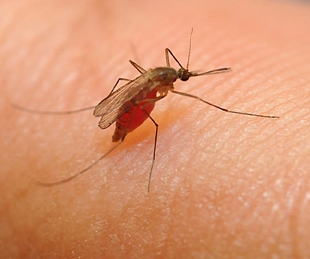
A native of New Jersey, Reisen holds a doctorate in zoology (1974) from the University of Oklahoma, Norman, with a focus on medical microbiology and ecology.
Throughout his career, Reisen directed collaborative projects ranging from field evaluations of genetically modified mosquitoes to aerial applications of insecticides, the vector competence of mosquitoes for endemic and newly introduced viruses, established new molecular surveillance testing paradigms for arboviruses, and initiated interactive networks for sharing surveillance data with mosquito control agencies and public health officials to speed mosquito control response times and to minimize disease risk to humans, according to Craig Downs, general manager of the Contra Costa MVCAC District.
His colleagues can attest to his work. Said Downs: “Several examples of his continual scientific contributions include: the effects of climate variation on arthropod-borne pathogen transmission, modeling efforts for predicting arbovirus risk, the application of insecticides for reducing the disease burden of West Nile virus in California, the use of liquid suspension array technologies for the identification of mosquito blood meals and his keen observation of the role of stagnant swimming pools as breeding sites for Culex spp. vectors in Kern County."
Reisen's medical entomology career includes the U.S. Air Force, University of Maryland School of Medicine, UC Berkeley School of Public Health and the Center for Vectorborne Diseases at UC Davis School of Veterinary Medicine. He directed the Arbovirus Field Station in Bakersfield from 1980-2013 and the Center for Vectorborne Diseases, based at UC Davis, from 2009 to 2014.
In recognition of his contributions to research, service and graduate training, Reisen was awarded Lifetime Award for Achievement in Medical Entomology and the Distinguished Service Award by the Society for Vector Ecology; Fellow, Entomological Society of America; Academic Federation Award for Excellence in Research, University of California, Davis; John N. Belkin Award for Excellence in Vector Ecology, American Mosquito Control Association; and the Harry Hoogstraal Medal, American Society of Tropical Medicine and Hygiene.
Thomas Scott, emeritus professor of entomology at UC Davis and known for his work on the dengue/yellow fever mosquito, Aedes aegypti, described Reisen as “an international leader in mosquito ecology and arbovirus epidemiology. His contributions to his field of study are stunning. His prolific, detailed field and laboratory studies have reshaped the way we think about mosquito-borne pathogen transmission dynamics. He has greatly improved disease prevention programs.”
Yes, Bill Reisen has greatly improved disease prevention programs and the lives of many people, far and wide, and too many to mention. Outstanding service. Outstanding contributions. Outstanding mentor.


- Author: Kathy Keatley Garvey
Make way for the new beekeepers! Or "beeks," as they fondly call themselves in the apiary industry.
A short course on "Planning Ahead for Your First Hive" drew an enthusiastic group of prospective beekeepers last Saturday, Feb. 13 at the Harry H. Laidlaw Jr. Honey Bee Research Facility on Bee Biology Road, University of California, Davis.
Aimed at those with little or no beekeeping experience, the all-day course included lectures and hands-on experience. The instructors--Extension apiculturist Elina Niño, Bernardo Niño, Charley Nye and Patricia "Tricia" Bohls--explained what beekeeping is all about. The lectures covered honey bee biology, beekeeping equipment, how to start your own colony, and maladies of the hive. The participants also learned how to build a hive, how to install a package, how to inspect your hive, and how to monitor for varroa mites.
This was the first in a series of several beekeeping courses that began Feb. 13 and will conclude on March 20. All classes are filled, but folks can contact Bernardo Niño at elninobeelab@gmail.com or call 530-380-BUZZ (2899) to be put on a list.
Meanwhile, the instructors are busily gearing up for these courses, all filled:
Working Your Colonies on Feb. 20: For novice beekeepers who already have a colony and/or have taken a previous course, and seek to develop their skills. Lectures will cover maladies and biology review, products of the hive, and troubleshooting problems in the colony. Hands-on information will encompass colony evaluations, monitoring and managing pests, feeding your colony, and honey extraction.By the end of the course, participants will be knowledgeable about evaluating colonies, solving common beekeeping problems, extracting honey and wax, trapping pollen and propolis, and treating colonies for pests, the instructors said.
Queen-Rearing Techniques: (two separate sessions) March 12-13 and March 19-20: Topics will include honey bee queen biology, basics of selective honey bee breeding programs, various queen-rearing techniques, testing hygienic behavior, and assessing varroa mite levels. Participants will have the opportunity to learn about and practice multiple methods for queen rearing. “We will go through a step-by-step process for queen rearing via grafting, including setting up cell builders and mating nucs,” Elina Niño said.
The Niño lab launched a website last year at http://elninobeelab.ucdavis.edu/, and administers a Facebook page at https://www.facebook.com/elninolab/. In addition, Elina Niño writes a bi-monthly apiculture newsletter, free and online.


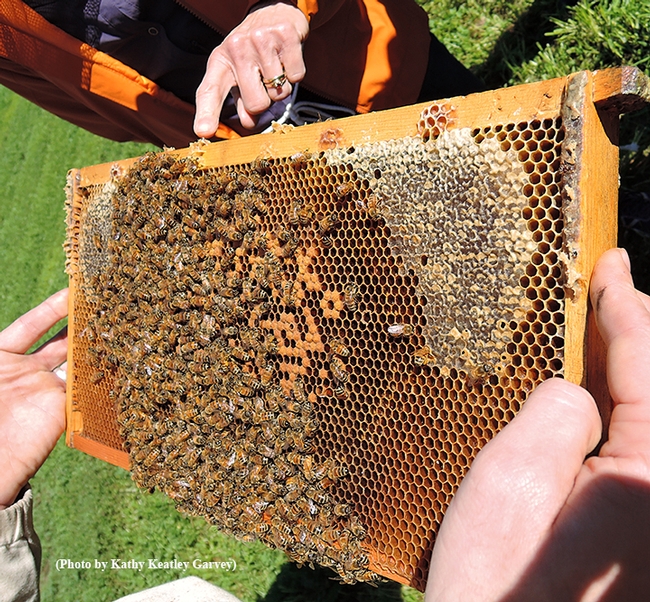


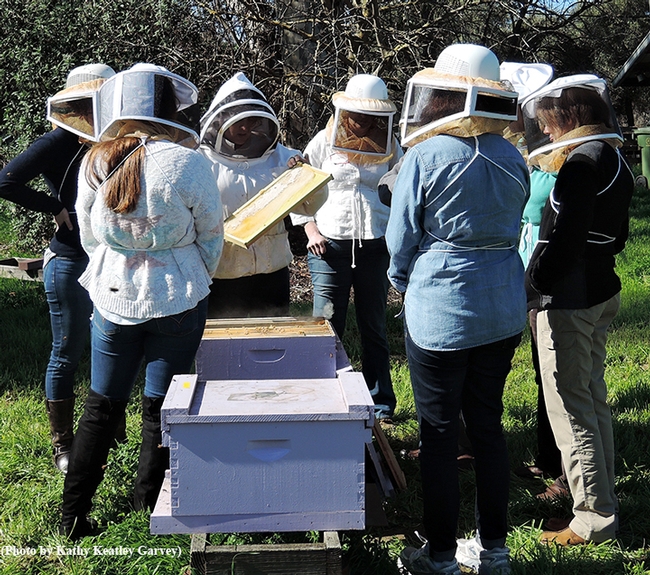

- Author: Kathy Keatley Garvey

The UC Davis-trained entomologist, author of the newly published paperback book, The Reason for Flowers: Their History, Culture, Biology, and How They Change Our Lives, "has been on the cutting edge of many areas of pollination biology," said Robbin Thorp, distinguished emeritus professor of entomology at UC Davis who served as his major professor. Buchmann, who received his doctorate in entomology from UC Davis in 1978, is a researcher and adjunct professor in the departments of entomology and ecology and evolutionary biology at the University of Arizona, Tucson.
"Steve jumps onto new ideas with great enthusiasm and explores them in depth," Thorp said. "He has been a leader in areas like buzz pollination, the contribution of electrostatics in pollen harvesting by bees, and adaptations in bees that collect oils from specialized flowers. He raised important issues about the conservation of bees in co-authoring the benchmark book, The Forgotten Pollinators, a decade before colony collapse disorder (CCD) in honey bees captured the attention of the media and general public."

Thorp and Buchmann are among the instructors at The Bee Course, which attracts conservation biologists, pollination ecologists and other attendees from all over the world. It's affiliated with the American Museum of Natural History.
So last year when Simon & Schuster published Buchmann's latest book, Reason for Flowers, it drew quite a splash. Bee scientists and bee enthusiasts, teachers and students, and lovers of flowers and just plain lovers, grabbed copies of the book, which, as of Feb. 9, is now in paperback. National Public Radio (NPR) interviewed him.
One word immediately grabbed everyone's attention: "sex."
"The reason for flowers is actually one word: sex," Buchmann told NPR's Arun Rath. "So, flowers are literally living scented billboards that are advertising for sexual favors, whether those are from bees, flies, beetles, butterflies or us, because quite frankly most of the flowers in the world have gotten us to do their bidding. But that's only the first stage because flowers, if they're lucky, turn into fruits, and those fruits and seeds feed the world."
A scientist who seemingly never sleeps, Buchmann has published more than 150 scientific articles and 11 popular nonfiction books, including The Forgotten Pollinators (a Los Angeles Times Book Prize finalist) with Gary Nabhan. His book, Honey Bees: Letters from the Hive, is a National Science Teachers' Association Outstanding Science Trade Book. He's also written a children's book The Bee Tree (with Diana Cohn), described as the true story of a family of honey hunters in peninsular Malaysia.
So, we asked Buchmann to provide "10 reasons for flowers." He provides greater detail in his book, but here are 10 reasons:
- Flowers Feed The World. Because pollinated and fertilized blossoms turn into nutritious fruits and seeds, these invaluable foodstuffs keep the world's 7.2 billion people from starvation. These resulting fruits also feed birds, bears and other wildlife.
- Tasty and Nutritious. Although the calories from starchy cereals and grain crops feed the world, we enjoy and need the “nutraceuticals” and antioxidants inside colorful cranberries, blueberries, oranges and apples. They keep us healthy and happy.
- Edible flowers. Some flowers (e.g. roses, some marigolds) are great as edible garnish and foods. Find out which ones can be eaten and what they taste like.
- Humans might never have evolved, or survived. Early hominids certainly recognized that flowers were the harbingers of tasty fruits. Without flowers, perhaps no people today.
- Flowers make us smile. Give someone a flower(s) and they flash a genuine Duchenne smile. Rutgers psychologist Dr. Jeanette Haviland-Jones has infused subliminal amounts of rose and gardenia vs. manmade scents into room air. Subjects use more enjoyment words and were more likely to approach or touch a stranger when the floral scents were present. Flowers may counteract the semiochemicals for fear, anger and anxiety that humans seem to constantly be emitting.
- 200 million red roses! Americans buy about 10 million cut blooms every day. On Valentine's Day that can jump to 200 million cut flowers, especially red roses. Most of these flowers are grown in Columbia and Ecuador then arrive in the bellies of jumbo jets arriving at the Miami airport.
- As costly as gold. Saffron is the world's costliest spice and the subject of countless fake imitations. The spice is the dried styles from crocus blooms. Hand-picking and the fact that this represents such a tiny fraction of the entire plant, make it so costly and precious.
- For inspiration and romance. Flowers have inspired generations of poets, writers and artists. Their myriad shapes, colors and scents enrich our lives with beauty. Their sexuality and alluring scents bring romance into our lives.
- Most ancient. The world's earliest known flower is the 8-inch tall fossil Achaefructus that grew in China 130-160 million years ago. Turns out that these and other early blooms were puny runts. They wouldn't win best of show ribbons in any flower show.
- Flowers in the service of science. Without Gregor Mendel's crossing experiments with the humble garden pea, we wouldn't have learned about the laws of inheritance when we did.
So, flowers feed the world, keep us healthy and make us smile. What could be better than that?
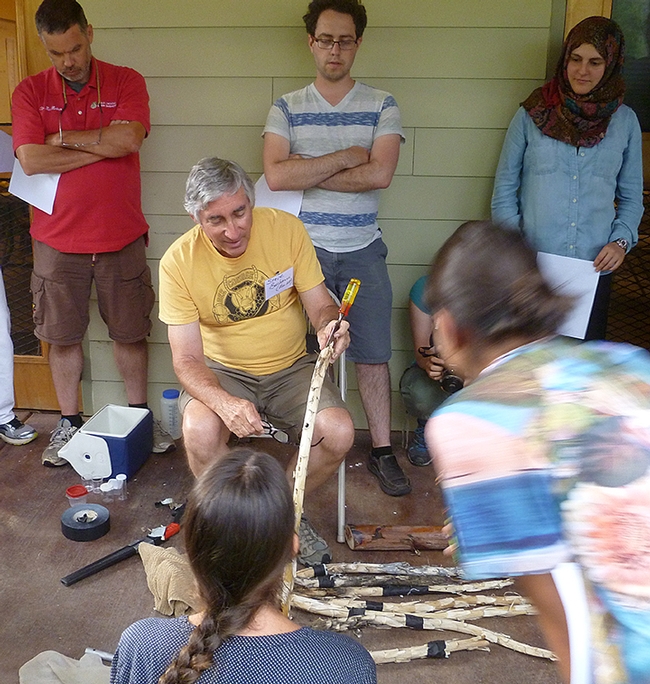
- Author: Kathy Keatley Garvey

Disheveled and depressed. Desolate and defeated. Weary and worn.
Is that really Bruce Hammock, the distinguished professor who holds a joint appointment in the UC Davis Department of Entomology and Nematology and the UC Davis Comprehensive Cancer Center?
It is.
He and his wife, Lassie, portray cameo roles as drought-ravaged farmers in the newly released indie, The Last Survivors, directed by their son, Tom Hammock. Starring Jon Gries, Haley Lu Richardson and Booboo Stewart, The Last Survivors has been described as a low-budget cross between Mad Max and The Hunger Games. (See trailer on YouTube)
And where are Bruce and Lassie Hammock in the film? They're in the grave-digging scene. They're standing at the back, Bruce comforting his wife as they mourn the death of a fellow farmer and worry about their future.
The official synopsis: "At the edge of an expansive barren valley, all that remains of The Wallace Farm for Wayward Youth is a few hollowed-out husks of buildings. Seventeen- year-old Kendal (Haley Lu Richardson) can barely recall when the Oregon valley was still lush. It's been a decade since the last rainfall, and society at large has dried up and blown away. Kendal and the few others that remain barely scrape by while dreaming of escape. When a greedy water baron lays claim to what little of the precious resource remains underground, Kendal must decide whether to run and hide or bravely fight for the few cherished people and things she has left. Co-starring Booboo Stewart (The Twilight Saga), Max Charles (The Amazing Spider-Man, Mr. Peabody & Sherman) and genre veteran Barbara Crampton (You're Next, Re-Animator), The Last Survivors is a suspenseful look at a futuristic world where only the most resourceful survive.."

For The Last Survivors, Director Tom Hammock asked both his parents and brother Bruce to serve in cameo roles. The younger Bruce, a postdoctoral researcher working on insect ecology in the UC Davis School of Veterinary Medicine, plays a "bad guy on a water truck."
Professor Bruce Hammock is better known in academic and administrative circles as the director of the campuswide Superfund Research Program, National Institutes of Health Biotechnology Training Program, and the National Institute of Environmental Health Sciences (NIEHS) Combined Analytical Laboratory. He just recently formed the company, EicOsis LLC, to target neuropathic and inflammatory pain and received a $4 million federal grant to advance his compound discovery through Phase 1 clinical trials. He is a fellow of the National Academy of Inventors, a fellow of the Entomological Society of America, a member of the prestigious National Academy of Sciences, and the recipient of the 2001 UC Davis Faculty Research Lecture Award and the 2008 Distinguished Teaching Award for Graduate and Professional Teaching. He's also an athlete who engages in white-water rafting and hiking.
Here at UC Davis, we call Bruce Hammock "The Genius." That's because he is. And now, he's an actor.
For the December 2013 shoot in the Mojave Desert (meant to depict a drought apocalypse in Oregon), the professor grew a beard, donned his father's old ragged World War II clothes and worn-out shoes, and practiced looking forlorn and haggard.
How would he describe his future in acting? "Brief and undistinguished," he joked, adding 
The Last Survivors, initially named The Well, is getting a lot of play. It's now on Showtime, Netflix and Amazon.
The crew worked hard, Bruce Hammock recalled. “We were on the set at 5:30 a.m. We worked until dark, in weather well below freezing, with high winds blowing sand. The professional actors and actresses put in amazing performances under quite adverse conditions. They're a very professional and fun group. I had never realized the complexity of filming a movie. I hope they pull off their vision.”
Son Tom Hammock initially thought of becoming a biologist. A 1994 graduate of Davis High School, he studied biology at UC Berkeley, and then switched to landscape architecture. After receiving his bachelor's degree in landscape architecture, he headed off to the American Film Institute to study film design. His credits including serving as the production designer for the critically acclaimed horror films, All the Boys Love Mandy Lane and You're Next, and working on such film productions as Breaking Bad, Dexter, and Charlie and the Chocolate Factory. He is now very much involved in the hugely popular young adult and horror film genre, but showed more of his talent when he authored the original graphic novel, “An Aurora Grimeon Story—Will O' the Wisp." (See previous Bug Squad blog)
Warning: Before you sit down to watch The Last Survivors, be sure to have a bottle of water at the ready, and a jar of canned peaches, too. You will be craving both.
Link:
Last Survivors on Facebook



